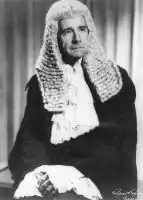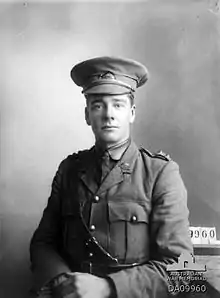Thomas Maltby
Major Sir Thomas Karran Maltby (17 October 1890 – 2 June 1976) was a politician in Victoria, Australia. He was a member of the Victorian Legislative Assembly for nearly 32 years from 1929 to 1961, served in several ministries and was Speaker of the assembly from 1947 to 1950.
Sir Thomas Maltby | |
|---|---|
 | |
| 21st Speaker of the Victorian Legislative Assembly | |
| In office 2 December 1947 – 12 April 1950 | |
| Preceded by | Sir George Knox |
| Succeeded by | Archie Michaelis |
| Member of the Victorian Legislative Assembly for Barwon | |
| In office 6 July 1929 – 22 April 1955 | |
| Preceded by | Edward Morley |
| Succeeded by | District abolished |
| Member of the Victorian Legislative Assembly for Geelong | |
| In office 28 May 1955 – 1 June 1961 | |
| Preceded by | James Dunn |
| Succeeded by | Hayden Birrell |
| Personal details | |
| Born | Thomas Karran Maltby 17 October 1890 Barnadown, Victoria |
| Died | 2 June 1976 (aged 85) Geelong, Victoria, Australia |
| Political party | Liberal and Country Party |
| Other political affiliations | Nationalist Party United Australia Party Liberal Party Independent |
| Spouse(s) | Eliza Margaret McDonald
(m. 1913) |
| Awards | Mentioned in Despatches (1918) |
| Military service | |
| Allegiance | Australia |
| Branch/service | Australian Army |
| Years of service | 1915–1919, 1940–1943 |
| Rank | Major |
| Unit | 5th Battalion |
Early life
Matlby was born in Barnadown, a small town near Bendigo, Victoria, to Thomas Karran Maltby (a shopkeeper from the Isle of Man) and Ada Agnes Fascher. His father died in 1893, and his mother remarried the following year. Maltby was educated at Camp Hill Central School, but left school aged 11 to work as a newsboy and shop messenger. He attended the Bendigo School of Mines at night, studying to receive an engineer's certificate, while working as a battery boy and later trucker in the Bendigo gold mines.[1]
Around 1909, Maltby moved to Melbourne where he worked as a labourer on the Melbourne Tramways. He later joined the sugar refinery CSR as an engine driver and clerk. In 1911, he joined the Militia (citizen army reserve) and received a commission the next year. In 1913, he married Eliza McDonald, a typist, at the Presbyterian Church in Yarraville.[1]
Military service

Already an officer of the citizens' militia, Maltby was appointed as a lieutenant in the First Australian Imperial Force on 16 May 1915. He embarked for Egypt in September that year, and by March 1916 was fighting on the Western Front with the Australian 5th Battalion.[1] His 11-month-old daughter, Margaret, died of pneumonia on 30 March 1916, while Maltby was serving overseas.[2]
Maltby was wounded twice during the war, once when a bolt from an exploding rifle entered his arm in April 1917. He was mentioned in dispatches before returning to Australia in 1919.[1]
During World War II, Maltby (a serving politician at the time) re-enlisted in the army where he served as quartermaster general from 1940 to 1943, and was promoted to Major.[3]
Political career
After his discharge from the army, Maltby became a storekeeper in Drysdale, then a real estate agent in Geelong. He was active in community affairs, and was president of both the Geelong Returned Sailors', Soldiers' and Airmen's Imperial League and the East Geelong Progress Association (which he had founded).[3]
His first attempt at a career in state politics was in 1924, when he unsuccessfully contested the Victorian lower house seat of Geelong as a Nationalist candidate against sitting Labor member William Brownbill at the 1924 Victorian state election.[3]
Five years later, Maltby was elected to the legislative assembly when he won the state by-election for the seat of Barwon, following the death of the Nationalist member Edward Morley.[3]
Crossbencher
On two occasions in his political career, Maltby had a split with the United Australia/Liberal Party and sat in the assembly on the crossbenches. In 1941, Maltby advocated for a UAP conference with the United Australia Organisation to discuss reform and reorganisation of the UAO. When the party passed a resolution refusing such a meeting, Maltby walked out of the party room meeting and moved his documents and personal effects to the Independents' room at Parliament House.[4] He did not resign from the UAP, but disassociated himself from his party colleagues and sat on the Opposition crossbenches for several months before returning.[5]
In September 1945, Maltby was one of five Liberal Party members to cross the floor and vote with the Labor Party and the Independents to defeat an appropriation bill. The Country–Liberal coalition government of Albert Dunstan and Thomas Hollway collapsed, and the Governor of Victoria, Sir Winston Dugan commissioned Ian Macfarlan to form a "stop-gap ministry" with the sole purpose of passing supply. Maltby was appointed Deputy Premier, Chief Secretary and Minister for Electrical Undertakings in the short-lived ministry, which lasted from 2 October to 21 November 1945.[6] Maltby was expelled from the Liberal Party for his defection,[7] but was re-admitted to the party in 1946.[8]
Speaker of the Legislative Assembly
On 2 December 1947, Maltby achieved what he called "a boyhood ambition" when he was elected Speaker of the Victorian Legislative Assembly.[9]
Maltby was knighted in the King's Birthday Honours on 9 June 1949 for his work as Speaker.[10]
Hollway Ministry
In May 1950, Arthur Warner, the Minister of Electrical Undertakings, asked Premier Tom Hollway to relieve him of his duties due to a conflict of interest involving Warner's association with several electrical companies. Hollway agreed, and Maltby was one of the front runners to replace Warner in the ensuing reshuffle, provided he was not renominated as Speaker.[11] On 19 June, Maltby was sworn into the Electrical Undertakings portfolio, as well as the Mines portfolio previously held by Henry Bolte.[12] However, Maltby's place in cabinet was to be once again short-lived: eight days later, the Hollway government collapsed when the Labor Party agreed to support a minority Country Party government led by John McDonald.[1]
Bolte Ministry
At the 1955 election, Maltby's electorate of Barwon was abolished, so he stood for and won the seat of Geelong, the seat he had contested over thirty years earlier.
On 7 June, Maltby was made Commissioner of Public Works in the Bolte Ministry. He was also made Minister of Housing[13] but was replaced the next day by Horace Petty.[14] In 1959, Maltby toured public buildings and studied road building and construction in the United States and Britain. He reported on his findings in the Report on his mission abroad, published in Melbourne in the same year.[15]
Death
Maltby died in Geelong, aged 85, on 2 June 1976.[16]
References
- Robert Murray, 'Maltby, Sir Thomas Karran (1890–1976)', Australian Dictionary of Biography, National Centre of Biography, Australian National University,, accessed 8 March 2013.
- "Family Notices". The Argus. Melbourne: National Library of Australia. 1 April 1916. p. 11. Retrieved 18 May 2012.
- Maltby, Sir Thomas Karran, Re-Member (Parliament of Victoria).
- "UAP MEMBER LEAVES PARTY ROOM". The Argus. Melbourne: National Library of Australia. 3 December 1941. p. 5. Retrieved 8 March 2013.
- "MAJ. MALTBY WILL MEET SUPPORTERS". The Argus. Melbourne: National Library of Australia. 5 December 1941. p. 3. Retrieved 8 March 2013.
- "END OF STAFF PARLIAMENT". The Horsham Times. Vic.: National Library of Australia. 5 October 1945. p. 2. Retrieved 8 March 2013.
- "Victorian Premier Virtually Expelled From Liberal Party". The Advocate. Burnie, Tas.: National Library of Australia. 10 October 1945. p. 5. Retrieved 8 March 2013.
- "Three Members Rejoin Liberal Party". The Argus. Melbourne: National Library of Australia. 11 December 1946. p. 3. Retrieved 8 March 2013.
- "NEW SPEAKER". The Argus. Melbourne: National Library of Australia. 3 December 1947. p. 1. Retrieved 8 March 2013.
- MALTBY, Thomas Karran (Knight Bachelor), It's an Honour, 9 June 1949.
- "State leadership reshuffle MINISTER QUITS CABINET POST". The Argus. Melbourne: National Library of Australia. 24 May 1950. p. 1. Retrieved 8 March 2013.
- Ministers of the Crown, Victoria Government Gazette, No. 528, 19 June 1950.
- "Ministers of the Crown (per 5698/55)". Victorian Government Gazette. 7 June 1955. p. 1955:2803.
- "Ministers of the Crown (per 5835/55)". Victorian Government Gazette. 8 June 1955. p. 1955:2845.
- Maltby, Sir Thomas: Report of his mission abroad, National Library of Australia, 1959.
- "Dies at 85". The Canberra Times. 50 (14, 395). Australian Capital Territory, Australia. 3 June 1976. p. 3. Retrieved 14 March 2018 – via National Library of Australia.
| Victorian Legislative Assembly | ||
|---|---|---|
| Preceded by Edward Morley |
Member for Barwon 1929–1955 |
District abolished |
| Preceded by James Dunn |
Member for Geelong 1955–1961 |
Succeeded by Hayden Birrell |
| Political offices | ||
| Preceded by Thomas Hollway |
Deputy Premier of Victoria 1945 |
Succeeded by Frank Field |
| Preceded by Herbert Hyland |
Chief Secretary 1945 |
Succeeded by Bill Slater |
| Preceded by John McDonald |
Minister-in-Charge of Electrical Undertakings 1945 |
Succeeded by Pat Kennelly |
| Preceded by Sir George Knox |
Speaker of the Victorian Legislative Assembly 1947–1950 |
Succeeded by Archie Michaelis |
| Preceded by Arthur Warner |
Minister-in-Charge of Electrical Undertakings 1950 |
Succeeded by Keith Dodgshun |
| Preceded by John James Sheehan as Minister in Charge of Housing |
Minister of Housing 1955 |
Succeeded by Horace Petty |
| Preceded by Samuel Merrifield |
Commissioner of Public Works 1955–1961 | |
